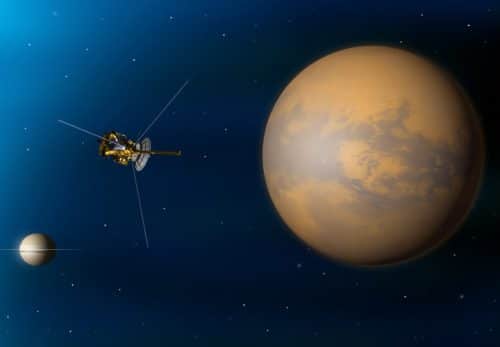NASA's Cassini spacecraft orbiting the planet Saturn, and studying it, its rings and its moons is approaching the grand finale of its mission. Today, April 26, 2017, she will perform the first of 22 dives under the rings of Saturn - between the rings and the planet

NASA's Cassini probe, which orbits the planet Saturn and studies it, its rings and its moons, is approaching the grand finale of its mission. Today, April 26, 2017, she will perform the first of 22 dives under the rings of Saturn - between the rings and the planet.
Cassini was launched on October 15, 1997 from the Cape Canaveral Spaceport, Florida and entered Saturn orbit on July 1, 2004. On December 24, 2004, the Huygens probe was separated from Cassini, and on January 14, 2005 it landed on Saturn's moon Titan. Immediately upon its landing, the probe began to transmit images from the landing site and it became clear that despite the enormous distance from the Sun, Titan has many features similar to those of the Earth. Initially it was planned to operate until 2008, then the mission was extended to 2011, and then for the second and last time to 2017.
Cassini performed a final flyby, the 127th in number, on the surface of the moon Titan at a distance of about a thousand km from its surface.
Cassini transmitted the images and other data following the encounter to Earth. Scientists using the Cassini radar instrument have observed new images of seas and lakes made of hydrocarbons on Titan's surface. This area has been photographed in part in the past by Cassini's regular camera - the one that works in visible light. But not by radar. The radar team also plans to use the new data to study the depth and structure of some of Titan's small lakes for the first (and last) time.
"Cassini's closest flyby of Titan is now behind us, but the rich amount of data collected by the spacecraft will serve researchers for decades," said Linda Spilker, project manager for the Cassini mission at NASA's Jet Propulsion Laboratory in Pasadena, California.
Cassini used Titan's gravity to change its orbit so that instead of passing just outside Saturn's main rings, Cassini will begin a series of 22 dives between the rings and Saturn on April 26. The mission will conclude with a science-rich descent into Saturn's atmosphere on September 15, bringing it to an end
"Through this flyby, we start with the Gand finale," said Earl Mays, project manager at JPL. "The spacecraft is now in a ballistic orbit, so even if we forgo future orbit adjustments using the engines, the spacecraft would still have entered Saturn's atmosphere on September 15th no matter what."
Cassini increased its speed by 860 meters per second. After passing by Titan, Cassini continued on and reached the farthest point in its orbit around Saturn on April 22. This point - the apogee is the highest point reached by the spacecraft in each orbit. Since then she starts diving, and will reach the maximum depth today, April 26, at 12 noon Israel time. The spacecraft will be out of communication range during the dive for a day but will continue to make scientific observations of the planet. The earliest time when Cassini is supposed to resume its transmissions is around 22:00 Israel time on April 27. Photos and other data will be downloaded from it shortly after communication is restored.
More articles on the subject on the science website:

2 תגובות
right. Already correcting T.L.H
Note: In the fifth paragraph below the image of the moon Titan
It says: "...Cassini will begin a series of 22 dives between the rings and Earth..."
Should be: "….Cassini will begin a series of 22 dives between the rings and Saturn…."
Tl